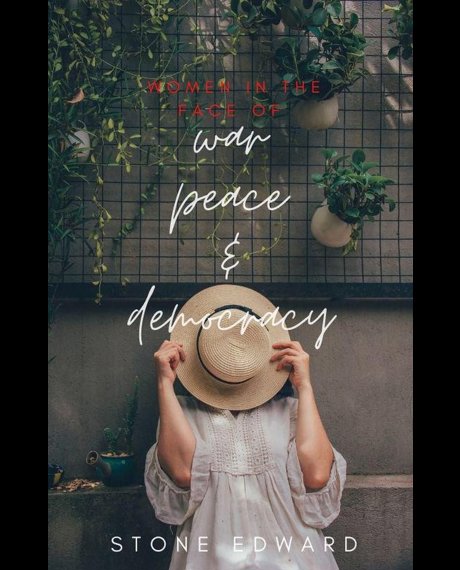Women In The Face Of War, Peace & Democracy
Women In The Face Of War, Peace & Democracy
€ 2,99
The aim of this work is to analyze the components that gave life to the pacifist universe, the most emblematic characters and the most significant moments of a path of theoretical and practical definition to which both men and women contributed. I tried to understand why their elaborations and their opposition to wars did not obtain the hoped-for success, a fact that gave rise to conflicts and deep rifts. In particular, I wanted to see what the war experience produced in a diverse mix of feminists, pacifists and suffragists. That is to say, what influences their political culture and their associations underwent in direct contact with the male pacifist associations; what transformations they experienced in the distant but equally engaging confrontation with the socialists and the anti-militarists.
To better understand these facts, I have considered a chronological span that goes from the end of the 1970s to the end of the First World War. During those decades an idea of peace took shape and a movement committed to translating it into reality which, despite being able to count on vast international ramifications, both in Italy and in other Western countries, was the expression of a minority, of an elite, even if generous and passionate. Despite its small size, the transnational network of activists and activists was extremely important because through it it was possible to exchange ideas, information and suggestions. Traveling through Europe and the United States, that sort of international of pacifism made an appointment several times.
Defined by many as utopians and dreamers, the militants and militants did not reject such appellations, convinced that, with propaganda and action, they were giving life to something capable of representing the ideals of brotherhood and justice to which all humanity had to aspire. In their elaborations, peace and rights, democracy and Europeanism were closely connected and there were different analyzes on how to reach them, with what means and with which allies. At times it was possible a joint work between the various exponents: entrepreneurs, professionals, artisans, workers, politicians, writers, philanthropists and journalists; at other times the differences prevailed and produced no results. Nevertheless, the idea of progress, combined with the aspiration for peace, it was the common denominator of a constellation of subjects coming from the progressive bourgeoisie and the democratic-liberal tradition. In this context, an important role was played by the Pro pace and arbitration group animated in Milan by Teodoro Moneta, who deserves credit for having been the catalyst among the small companies scattered throughout the country and for having strengthened contacts with the exponents of the others. villages.
The aim of this work is to analyze the components that gave life to the pacifist universe, the most emblematic characters and the most significant moments of a path of theoretical and practical definition to which both men and women contributed. I tried to understand why their elaborations and their opposition to wars did not obtain the hoped-for success, a fact that gave rise to conflicts and deep rifts. In particular, I wanted to see what the war experience produced in a diverse mix of feminists, pacifists and suffragists. That is to say, what influences their political culture and their associations underwent in direct contact with the male pacifist associations; what transformations they experienced in the distant but equally engaging confrontation with the socialists and the anti-militarists.
To better understand these facts, I have considered a chronological span that goes from the end of the 1970s to the end of the First World War. During those decades an idea of peace took shape and a movement committed to translating it into reality which, despite being able to count on vast international ramifications, both in Italy and in other Western countries, was the expression of a minority, of an elite, even if generous and passionate. Despite its small size, the transnational network of activists and activists was extremely important because through it it was possible to exchange ideas, information and suggestions. Traveling through Europe and the United States, that sort of international of pacifism made an appointment several times.
Defined by many as utopians and dreamers, the militants and militants did not reject such appellations, convinced that, with propaganda and action, they were giving life to something capable of representing the ideals of brotherhood and justice to which all humanity had to aspire. In their elaborations, peace and rights, democracy and Europeanism were closely connected and there were different analyzes on how to reach them, with what means and with which allies. At times it was possible a joint work between the various exponents: entrepreneurs, professionals, artisans, workers, politicians, writers, philanthropists and journalists; at other times the differences prevailed and produced no results. Nevertheless, the idea of progress, combined with the aspiration for peace, it was the common denominator of a constellation of subjects coming from the progressive bourgeoisie and the democratic-liberal tradition. In this context, an important role was played by the Pro pace and arbitration group animated in Milan by Teodoro Moneta, who deserves credit for having been the catalyst among the small companies scattered throughout the country and for having strengthened contacts with the exponents of the others. villages.
| Prijs | Verzendkosten | Totaal | |
|---|---|---|---|
€ 2,99 | € 0,00 | € 2,99 |
Alternatieve producten
© 2016 - 2024 aanbiedingchecker


/backgroundcolor(255,255,255)/jpg(90)/fetch/https://media.s-bol.com/mLN6v2E1q2r/798x1200.jpg)
/backgroundcolor(255,255,255)/jpg(90)/fetch/https://media.s-bol.com/RWL2wjzr5jR/756x1200.jpg)
/backgroundcolor(255,255,255)/jpg(90)/fetch/https://media.s-bol.com/Y269RzRNnx2/756x1200.jpg)
/backgroundcolor(255,255,255)/jpg(90)/fetch/https://media.s-bol.com/JG3V2w2xlDD/753x1200.jpg)